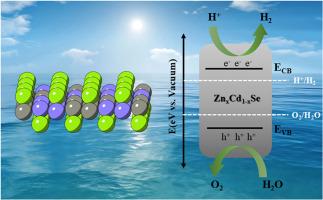First-principles calculations of electronic and optical properties of tetragonal ZnxCd1-xSe ternary monolayers
IF 2.9
3区 物理与天体物理
Q3 NANOSCIENCE & NANOTECHNOLOGY
Physica E-low-dimensional Systems & Nanostructures
Pub Date : 2025-07-21
DOI:10.1016/j.physe.2025.116336
引用次数: 0
Abstract
Alloying is a common approach for band gap engineering in semiconductors, allowing for systematic tuning of the band gap based on the alloy composition. The tetragonal ZnSe monolayers exhibit a pronounced quantum confinement effect, leading to a band gap increase compared to their zinc blende bulk counterparts. This study examines the electronic and optical properties of tetragonal ZnxCd1-xSe monolayers through first-principles calculations. Our findings demonstrate that these alloy monolayers exhibit direct band gap semiconducting behavior with tunable band gaps, making them promising candidates for ultraviolet–visible light-driven water splitting. Theoretical optical absorbance calculations further suggest that the Zn0.5Cd0.5Se and Zn0.625Cd0.375Se alloy monolayers outperform pristine ZnSe and CdSe monolayers in terms of absorption performance at certain wavelengths within the visible light region. Conversely, the Zn0.375Cd0.625Se monolayer exhibits superior absorption performance compared to pristine ZnSe and CdSe monolayers at specific wavelengths within the ultraviolet light region. These findings provide new insights into the alloy engineering of tetragonal ZnSe and CdSe monolayers, highlighting their potential for diverse optoelectronic applications.

四边形ZnxCd1-xSe三元单层的电子和光学性质的第一性原理计算
合金化是半导体带隙工程的一种常用方法,可以根据合金成分系统地调整带隙。方形ZnSe单层表现出明显的量子约束效应,导致带隙增加,相比于其锌矿体对应物。本研究通过第一性原理计算考察了方形ZnxCd1-xSe单层的电子和光学性质。我们的研究结果表明,这些合金单层具有可调带隙的直接带隙半导体行为,使其成为紫外-可见光驱动水分解的有希望的候选者。理论光学吸光度计算进一步表明,Zn0.5Cd0.5Se和Zn0.625Cd0.375Se合金单层在可见光区域内某些波长的吸收性能优于原始ZnSe和CdSe单层。相反,Zn0.375Cd0.625Se单层在特定波长的紫外光区表现出比原始ZnSe和CdSe单层更好的吸收性能。这些发现为方形ZnSe和CdSe单层的合金工程提供了新的见解,突出了它们在各种光电应用中的潜力。
本文章由计算机程序翻译,如有差异,请以英文原文为准。
求助全文
约1分钟内获得全文
求助全文
来源期刊
CiteScore
7.30
自引率
6.10%
发文量
356
审稿时长
65 days
期刊介绍:
Physica E: Low-dimensional systems and nanostructures contains papers and invited review articles on the fundamental and applied aspects of physics in low-dimensional electron systems, in semiconductor heterostructures, oxide interfaces, quantum wells and superlattices, quantum wires and dots, novel quantum states of matter such as topological insulators, and Weyl semimetals.
Both theoretical and experimental contributions are invited. Topics suitable for publication in this journal include spin related phenomena, optical and transport properties, many-body effects, integer and fractional quantum Hall effects, quantum spin Hall effect, single electron effects and devices, Majorana fermions, and other novel phenomena.
Keywords:
• topological insulators/superconductors, majorana fermions, Wyel semimetals;
• quantum and neuromorphic computing/quantum information physics and devices based on low dimensional systems;
• layered superconductivity, low dimensional systems with superconducting proximity effect;
• 2D materials such as transition metal dichalcogenides;
• oxide heterostructures including ZnO, SrTiO3 etc;
• carbon nanostructures (graphene, carbon nanotubes, diamond NV center, etc.)
• quantum wells and superlattices;
• quantum Hall effect, quantum spin Hall effect, quantum anomalous Hall effect;
• optical- and phonons-related phenomena;
• magnetic-semiconductor structures;
• charge/spin-, magnon-, skyrmion-, Cooper pair- and majorana fermion- transport and tunneling;
• ultra-fast nonlinear optical phenomena;
• novel devices and applications (such as high performance sensor, solar cell, etc);
• novel growth and fabrication techniques for nanostructures

 求助内容:
求助内容: 应助结果提醒方式:
应助结果提醒方式:


